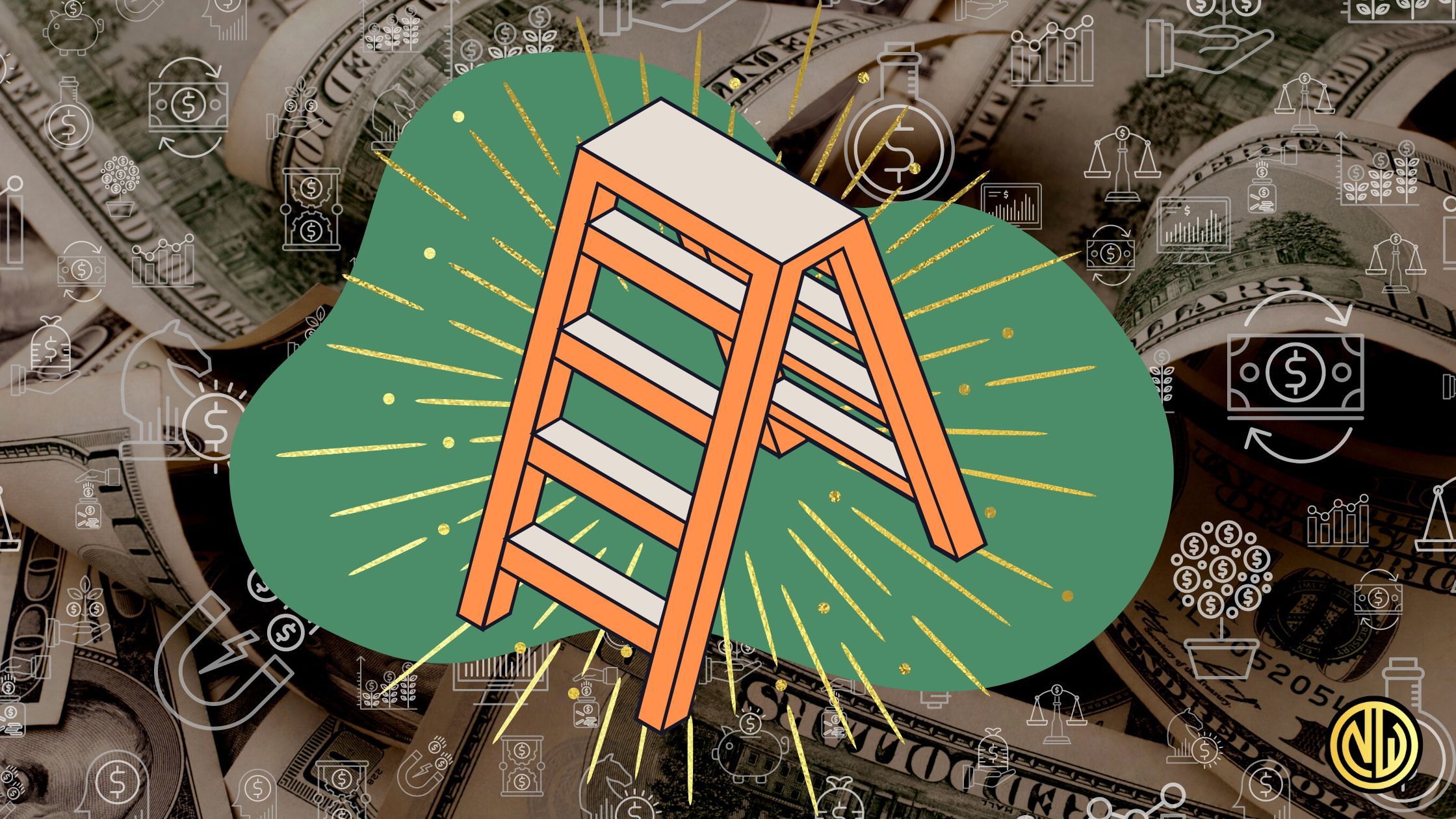Reminder/Legal Stuff:This post is not financial advice. It is intended for educational purposes only. Consult with your financial advisor or a certified financial professional for guidance on investment choices.
Financial independence culture absolutely loves hustle. The more hustle, the better! But what about when you’re ready to withdraw all that saved money ahead of retirement schedule — then what?
Enter the Roth conversion ladder. This strategy allows for tax-free withdrawals from your retirement accounts before the typical penalty-free withdrawal age of 59.5, sidestepping fees that can erode your nest egg. When you do a Roth conversion, you pay taxes on the money being transferred, since you’re moving money from a pre-tax account to a post-tax account.
By doing this in phases, you avoid a huge tax bill, and your future investment gains grow tax-free.
Key Takeaways
- The Roth conversion ladder is a strategic approach allowing individuals to transfer funds from a traditional IRA to a Roth IRA.
- The main point of a conversion is to avoid incurring early withdrawal penalties.
- Money has to sit in a Roth IRA for five years before being withdrawn, so this is a proactive retirement strategy.
- When you do the conversion, you’ll get a tax bill, since that money hadn’t been taxed yet.
- You would have paid taxes on this money anyway when you began normal withdrawals.
- If you’re in a much higher tax bracket now than you expect to be later in life, a Roth conversion ladder may not be right for you.
- For most, though, being able to sidestep the 10% early withdrawal penalty on 401(k)s is worth it.
Let's explain the Roth conversion ladder, assess its impact on your taxes, and talk through the long-game timing that makes it all work.
Table of Contents
Understanding the Roth Conversion Ladder
The Roth conversion ladder is a systematic approach that allows individuals to:
- Move funds from a traditional IRA, which offers tax-deferred growth, to a Roth IRA, where distributions are tax-free.
- Pay ordinary income tax on the converted amount, without incurring an early withdrawal penalty.
- Access funds before the age of 59.5.
This strategy is particularly beneficial for those dedicated to the Financial Independence, Retire Early (FIRE) movement.
Spread over several years, the conversion process involves transferring money from tax-deferred accounts into a Roth IRA, thus spreading the tax burden. The Roth conversion ladder not only helps to avoid the 10% early withdrawal penalty but also optimizes retirement savings for long-term benefit.
The Basics of a Roth Conversion Ladder
Establishing a Roth conversion ladder requires initiating the process a minimum of five years prior to your intended early retirement. This allows you to create a stream of tax-free income for early retirement by making annual conversions of a predetermined amount.
The idea is to plan a series of conversions that will provide a steady stream of income during your early retirement, before traditional retirement age.
TIP:Roth IRA conversions are best suited for those who believe they will be in a higher tax bracket during retirement, allowing them to pay taxes upfront at a potentially lower rate.
Benefits of Using a Roth Conversion Ladder
The Roth conversion ladder allows for:
- Tax-free and penalty-free income during early retirement.
- Significant tax-free retirement withdrawals before age 59.5.
- Enhanced flexibility in managing retirement income.
- A structured approach to early retirement planning, thanks to the 5-year waiting period for each conversion.
Another great advantage of utilizing a Roth IRA conversion ladder is that it contributes to tax diversification by using a mix of taxable and tax-free accounts. This helps lower taxes in retirement and promotes long-term tax savings.
Factors to Consider Before Implementing a Roth Conversion Ladder

So should you do a Roth conversion ladder?! My annoying editor answer, as usual, is “it depends.”
First, you should assess your career tax implications. If you anticipate being in a similar or higher tax bracket in retirement, a Roth conversion ladder could be good, because you’re going to owe that much tax anyway.
Another consideration is the impact of state income taxes on your retirement income. Depending on whether or not your state taxes retirement income, this could significantly affect the overall tax cost of a Roth conversion.
TIP:Financial advisors sometimes advise doing a Roth conversion during a market downturn to make lemons out of lemonade, since lower stock values mean less tax will be assessed.
The Pro-Rata Rule
The IRS’ pro-rata rule applies to IRA rollovers and conversions. This rule defines how converted funds will be taxed.
If your 401(k) has both pre-tax and post-tax contributions, you can still convert that money to a Roth, but the contributions converted will be at the same pre-tax/post-tax proportions as what’s currently in your account. This rule exists so that you can’t game the system with which funds get converted.
Consider the short-term tax consequences of Roth conversions, as the conversion amount increases your taxable income, potentially affecting your tax rates and Medicare Part B premiums.
Lastly, consider the opportunity cost to pay income taxes on conversions in a given year. Ensure that the long-term benefits outweigh the immediate tax bill expense.
Time Horizon and Retirement Goals
Another vital consideration during the implementation of a Roth conversion ladder is understanding your time horizon for when funds will be needed in retirement. This is critical in determining the optimal amount and timing of Roth conversions for achieving tax efficiency.
Timing plays a crucial role in conversions, as a longer investing timeline allows for more tax-free growth to offset the upfront cost of the conversion. When planning for a Roth conversion ladder, account for the potential growth of the converted Roth funds, as growth within a Roth IRA is tax-free and can compound over time.
This strategy can also be tailored to align with phased retirement plans, where income may gradually decrease, thereby potentially reducing the tax impact of conversions in later years.
How to Set Up a Roth Conversion Ladder
To begin, you’ll obviously need a Roth IRA. This could be an online broker if you prefer a hands-on investing approach or a robo-advisor for automated investment management. Make sure to consider factors like account fees, the range of investment options and the level of customer support offered.
Fund your Roth IRA account by transferring money from a bank account, rolling over assets from an existing IRA, or conducting a 401(k) rollover from a former employer.
Remember to be mindful of IRA annual contribution limits, which as of 2024 are $7,000 or $8,000 for individuals aged 50 or older.
Executing Conversions
Now that your Roth account is set up and funded, it’s time to execute the conversion. A Roth conversion is the transfer from a traditional IRA to a Roth IRA, and the amount converted to a Roth IRA is taxable as income. The taxes are calculated based on your highest marginal tax bracket.
To create a “ladder” of funds, you need to convert a traditional IRA to a Roth IRA each year over several years. It’s important to start this at least five years before the funds are needed to ensure that each conversion satisfies the five-year waiting period.
Managing Your Roth Conversion Ladder

After the establishment of your Roth conversion ladder, effective management is required to maintain favorable tax treatment. If your income changes, you may need to adjust your conversion amounts to avoid moving into a higher tax bracket inadvertently.
To stay on track with your Roth conversion ladder, follow these steps:
- Review your strategy annually to assess if your current financial situation aligns with the intended outcomes.
- If there are any changes in your income or tax situation, adjust your conversion amounts accordingly.
- Stay informed about changes to the tax code that could impact your Roth conversion ladder strategy.
Monitor Progress and Adjust Your Strategy
Keep a close watch on the progress of your Roth conversion ladder. Retirement calculators can aid in assessing whether your retirement savings are on track and if strategy adjustments are needed.
Understanding your true marginal tax rates, which consider the total change in tax liability due to a Roth conversion, can help you make informed decisions.
Consult with a financial or tax advisor to run projections and determine the break-even period. It’s also important to keep track of each conversion year to ensure that conversions are spaced out appropriately and comply with tax rules.
Bow To the 5-Year Rule
In terms of withdrawal strategies, the 5-year rule for Roth IRAs is crucial.
Roth IRAs also have a 10% early withdrawal penalty. But rather than being tethered to the arbitrary retirement age of 59.5, the penalty applies if funds are withdrawn less than five years after they were deposited. Each Roth IRA conversion has its own five-year period, commencing on January 1 of the tax year for which the first contribution was made.
Qualified withdrawals from Roth IRAs offer tax-free flexibility in managing retirement income, providing significant tax savings. IRS ordering rules for Roth IRA withdrawals first account for regular contributions, which can be taken out tax and penalty-free, offering immediate access to these funds.
Strategically planned withdrawals from a Roth IRA during retirement are vital in maximizing retirement savings and ensuring financial stability.
Potential Risks and Drawbacks of a Roth Conversion Ladder

Mmkay, sounds pretty cool. So what are the downsides of a Roth conversion ladder?
Paying taxes on a Roth conversion today can reduce the value of an individual’s estate, which may lead to lower potential federal estate taxes owed afterwards. However, converting traditional IRAs to Roth IRAs can be advantageous for legacy planning, as it may facilitate leaving assets to heirs while also potentially reducing the value of the estate subject to federal estate taxes.
For individuals with specific situations, like those with low required minimum distributions (RMDs), the benefits of a Roth conversion may not be as pronounced, given that the tax paid on the conversion might not offer substantial tax benefits.
Market Fluctuations
Market fluctuations can impact the effectiveness of a Roth conversion ladder.
Bear markets provide an opportunity for more effective Roth conversions as they may lower portfolio values, enabling larger proportions of funds to be converted at lower tax rates. Converting to a Roth during a market downturn means that the amount converted is taxed at its potentially lower current value rather than its possibly higher original value.
However, market volatility necessitates that investors consider the time needed to break even after a Roth conversion, factoring in the taxes paid upfront.
TIP:Many personal finance projections don’t factor in market fluctuation. This matters! Assume the market will go up and down regularly.
Legislative Changes
The Roth conversion ladder strategy can also be influenced by legislative changes. For instance, the SECURE Act 2.0 permits SEPs and SIMPLE IRAs to be designated as Roth IRAs for employees to make employer matching contributions as Roth contributions. Moreover, the SECURE Act modified the rules for Roth IRA beneficiaries, which affects the Roth conversion ladder strategy for estate planning.
It’s also important to stay informed about legislative discussions, which can pose possible threats to the Roth conversion ladder strategy.
Frequently Asked Questions
Is a Roth Conversion Ladder Worth It?
A Roth conversion ladder can be a valuable strategy for early retirement planning, as it allows for tax-efficient withdrawals. However, it is important to carefully manage conversions to avoid potential tax consequences.
What Is the 5-Year Rule for Roth Conversion Ladder?
The 5 year rule for a Roth conversion ladder states that you cannot withdraw investment earnings tax-free until at least five years have passed since you first contributed to a Roth IRA. If you withdraw earnings before this time, you may be subject to income taxes and a 10% penalty.
What Is the Downside of Roth Conversion?
The downside of a Roth conversion is that it can increase your taxable income for the year, potentially bumping you into a higher tax bracket, especially if you are in your peak earning years. Be mindful of this before making a decision.
What Is the Difference Between a Roth Conversion Ladder and a SEPP?
The main difference between a Roth conversion ladder and a SEPP is that the Roth conversion ladder offers more flexibility in choosing the withdrawal amount, while SEPP withdrawals are calculated according to specific formulas. This gives early retirees more control over their finances.
How Does a Roth Conversion Ladder Work?
A Roth conversion ladder entails yearly conversions from a traditional IRA to a Roth IRA, creating tax-free income for early retirement. Each conversion must fulfill a five-year waiting period before funds can be withdrawn tax-free.
The Takeaway
A Roth conversion ladder is a strategic tool that can help you achieve your early retirement dreams. Every financial journey is unique, so it’s always best to consult a tax or financial advisor to ensure your strategy aligns with your financial goals. ◆
Thanks For Reading 🙏🏼
Keep up the momentum with one or more of these next steps:
💬 Leave a comment below. Let me know a takeaway or thought you had from this post.
📣 Share this post with your network or a friend. Sharing helps spread the word, and posts are formatted to be both easy to read and easy to curate, with nice image previews. You'll look savvy and informed.
📲 Connect on another platform. I’m currently publishing in these places. If you are too, say hello:
- Medium: Articles and thought essays.
- Threads: Casual, Twitter-esque commentary.
- Instagram: Media appearances, and some occasional IRL posts to Stories.
- TikTok: Occasional video scraps from reporting and life.
- LinkedIn: Buttoned-up posts.
📬 Sign up for my free email list. “The Morning Walk” is a free newsletter about writing, online publishing, and personal entrepreneurship. Learn more and browse past editions here.
🏕 Up your writing game. Camp Wordsmith® is a content marketing strategy program for small business owners, service providers, and online professionals. Learn more here.
📊 Hire me for consulting. I provide 1-on-1 consultations through my company, Hefty Media Group. We're a certified diversity supplier with the National Gay & Lesbian Chamber of Commerce. Learn more here.


